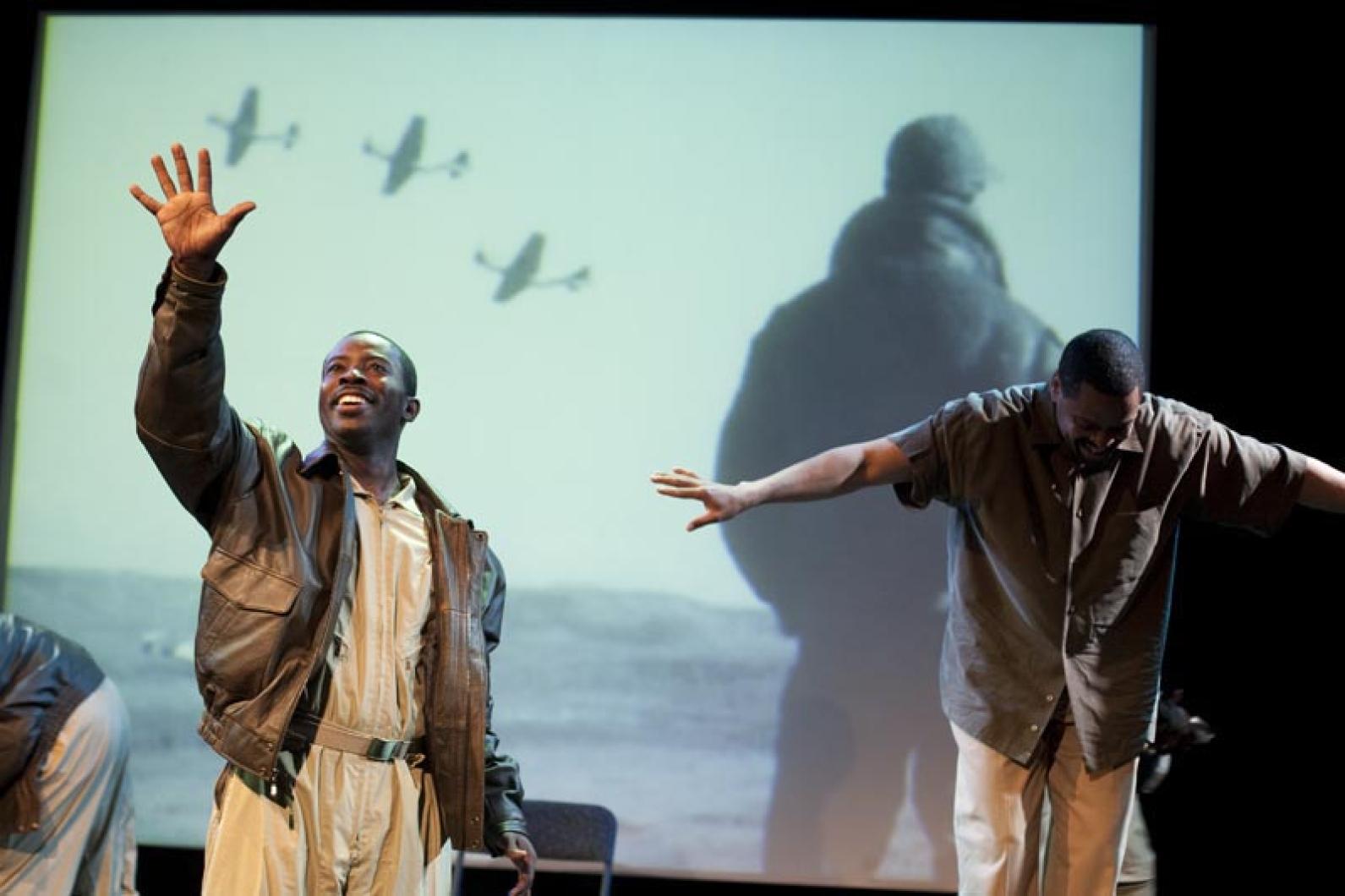“Gentlemen, I am tickled pink to be instructing you colored fliers,” announces white Captain O’Hurley (Joe Forbrich) to his black World War II aviation cadets, in a voice dripping more sarcasm than the crankcase of a P-40 Warhawk extrudes oil. In truth, at the time that the first black airmen were trained at Tuskegee Army Airfield in 1941, many believed the cadets lacked the intelligence and skill to fly a single-engine or multi-engine plane.
They were wrong.
From 1941 to 1956, 994 black airmen graduated from Tuskegee, in full receipt of commissions and pilot wings. The stunning successes of black pilots, navigators, bombardiers and gunnery crew during World War II led to the breakdown of segregated forces in the military, culminating in President Harry Truman’s 1948 issuance of Executive Order Number 9981 promoting full integration of the U.S. Armed Forces.
In the new play, Fly, which opened this past weekend at the Vineyard Playhouse, playwrights Trey Ellis and Ricardo Khan (who also directs) train the klieg lights on four of the first Tuskegee cadets, Chet (Charlie Hudson III), W.W. (Robert Karma Robinson), Oscar (Samuel T. Gaines) and J. Allen (Mark Hairston), all of whom jostle for alpha alignment in a field already alpha-ammo-ed to the max. The most flamboyant cadet is Chicago-bred W.W. If you slap on an extra W., he claims, his name stands for What Women Want. The chips on the aspiring airmen’s shoulders get knocked off by the offences heaped on them by their white trainers, both Capt. O’Hurley and Colonel Snopes (Walker Lewis), as bigotry gets an extra push by sneers about flying monkeys existing only in The Wizard of Oz.
The cadets tolerate the jibes because their passions propel them up into the stratosphere. As the tap-dancing narrator Tap Griot (Ted Louis Levy) explains, “There isn’t a cat in the world who doesn’t want to fly, black or white.” Pronounced gree-oh, the character is grounded in a West African tradition of the wandering poet, or bard.
A projection screen flashes images of receding airfields, while the actors wield white wooden chairs and contort their bodies to banish our disbelief and allow us to see swooping silver wings, fjords of passing clouds, a glimpse of eternity, then home again for a touchdown with perhaps just a slight scud to it.
When later the entire 9th Airborne roars to the skies over Berlin, two of our cadets, during breaks from downing Nazi pilots, give white American pilots a frisson of shock as they buzz close for a glimpse of their black faces. After one of the Tuskegee fliers shoots a German bomber from a white pilot’s flight path, he picks up his transmitter and scoffs, “You call me ‘boy’ one more time and I won’t get this other one off your tail.”
In these exciting vignettes from Fly we can see that, while it may have taken the U.S. a few more years to desegregate the military, a dawning respect and camaraderie united the airmen of the war.
Tony award-winning Mr. Khan, resident director at the Lincoln Center, a visiting professor in graduate theatre at the University of Missouri, and cofounder of Crossroads Theatre Company of New Brunswick, N.J., has managed to compress a world of complexities in race relations, aviation and war and peace with a handful of actors, cardboard trunks, scattered chairs and a projection screen. Costuming credits go to Toni-Leslie James and Chelsea McCarthy, properties by Kate Hancock, and casting by Michele Ortlip.
Lights! Action! and all things electrical were achieved with flair by Jim Novack, Fred Hancock, Andrea Myers and Alexandra Spohrer. Sound design and operation were provided by Ray Schilke and Jim Novack. Choreographer Hope Clarke braided the exuberant movements of the cadets with the dark and stormy percussion of Mr. Levy’s taps.
Artistic director and producer, M.J. Bruder Munafo once again earns praise for bringing exciting and original theatre to the Island. Matt Jackson is stage manager, assistant stage manager is Ryan Fotter, master carpenter is Paul Munafo, Geneva Monks is administrative assistant, house managers are Anna Marie D’Addarie and Linda Smith, poster and program are by Stephen M. Zablotny, and a tireless Gwyn McAllister rolled out publicity and promotions.
In attendance on Saturday night’s performance were Patricia Neal, Olga Hirshhorn and Eleanor Roosevelt’s granddaughter, Vineyarder Laura Roosevelt, who was specially invited because of Mrs. Roosevelt’s connection with the Tuskegee Airmen.
The hero of the hour is Martha’s Vineyard’s own Tuskegee Airmen veteran, Lieutenant Colonel James W. McLaurin. At a reception following the first weekend of Fly, this special member of the Boston chapter of Tuskegee vets (their ranks have dwindled to approximately 225) said to his audience, “I work with kids on the Island. I had people help me when I was young, and I want as many kids as possible to come to this show and learn about their history. I have a home here in Oak Bluffs where I stay in the summer. I’m around all the time and if anybody would like to learn more about the Tuskegee Airmen, I’ll leave my card, you can call or stop by anytime.” (F.Y.I. it’s a really cool card with a red-tailed single-engine fighter plane on it.)
After a thoughtful pause, he added, “I’ve got a lot of videos about the Airmen that I’ve watched many times, but this is the first time that I’ve gotten emotional at seeing our story told.”
Fly will run through July 11. For more information or for reservations, call 508-696-6300.






Comments
Comment policy »